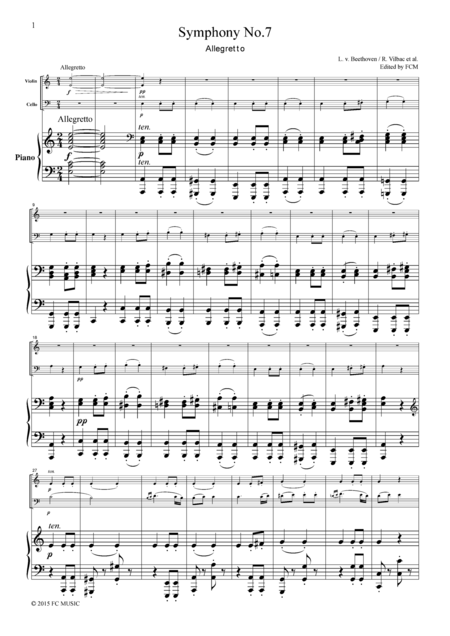

The second movement, Allegretto, was the most popular movement and had to be encored. Its theme is quickly established and has a hauntingly beautiful melody.īeethoven composed this Symphony while improving his health in the Bohemian spa town of Teplice. When the Seventh Symphony premiered in 1813, the second movement Allegretto was so popular the audience demanded an encore. This is unlike the slow 2nd movement of many symphonies. and the woodwinds playing the main theme, it used to remind me of the credit scene of the Jungle Book. The seventh of Beethoven’s nine symphonies, its premiere concert (December 1813 in Vienna) was performed at a charity concert in order to benefit the soldiers who had been wounded a few months prior in the battle of Hanau. I also like the end, with the soft strings pizz. 92), completed in 1812, might have been one of Ludwig Van Beethoven’s most popular pieces. as the second movement specifies allegretto and even the trio is merely. The instant popularity of the Allegretto resulted in its frequent performance separate from the complete symphony. Of Beethovens major symphonies (that is, in the sense of innovation and.
#Beethoven 7th symphony 2nd movement a major plus
Judging from their ecstatic Decemconcert in Symphony Hall, Boston (privately circulated) plus a. The second movement, Allegretto, was the most popular movement and had to be encored. Among so many fine versions of the Beethoven Seventh, just one major regret that Charles Munch and the Boston Symphony never rerecorded their prosaic and heavily-compressed 1949 set (RCA LP, Tahra CD) their first together. The countermelody is expert, and the slow crescendo is amazing. Beethoven composed this Symphony while improving his health in the Bohemian spa town of Teplice. His nine symphones are probably his greatest achievement, each one an unrivalved masterpiece, but he also wrote 5 piano concertos, piano sonatas, string quartets and one opera, Fidelio. 7 is great, but the 2nd movement in particular is astounding, one of the greatest musical achievements ever. 7 was also enthusiastically received, and its second movement so impressed his audience that it had to be played twice. A tormented genius, who went deaf in later life and never heard his final works. Vienna Symphony Orchestra.One of the greatest and most radical composers of all time. The dance-like rhythm of the first movement is maintained through the Allegretto tempo while maintaining its tonal change from the first. As evident in most of Beethoven’s works, there are parts in the movement that the theme starts from a quiet and small accentuation into a strong and sudden emphasis. By contrast, the second movement Allegretto is a funeral march in all but name. 7 in A Major, Opus 92 from a 1953 recording by the Vienna Philharmonic Orchestra conducted by Wilhelm Furtwängler. This song is sung by Wiener Philharmoniker. Second movement, Allegretto, of Beethovens Symphony No.


The ostinato in the piece is prevalent in the whole movement, acting as a support for the main theme played in succession by the brass and string sections. Allegretto song from the album Beethoven: Symphonies Nos.7 & 8 is released on Dec 1987.

When the music begins, we see a giant head pass across the screen, flying of its own volition towards some unknown location above the credits, and you just know that something amazingly weird is about to happen. The transition from the first movement is punctuated by its sad theme, yet the mood is counterbalanced with the Allegreto form. The second movement of Beethoven’s 7th Symphony is used in Zardoz at the very beginning, where it is sung in an operatic tone. The movement is ‘slow’ compared to the first, though the movement is in Allegreto form meaning, it is to be played in a lively manner. The second movement acts as the antithesis to the somewhat glorious mood of the first and also in consideration with its tempo. The second and third movements the slow one and. This expressiveness comes in form of subtle elegance mingled with a hint of sadness, though it still maintains its dance-like rhythm. In a four-movement symphony, there is a certain problem of overall construction that is easy to describe. Opus 92, second movement by Ludwig van Beethoven Order custom essay Symphony no.7 in A major.


 0 kommentar(er)
0 kommentar(er)
